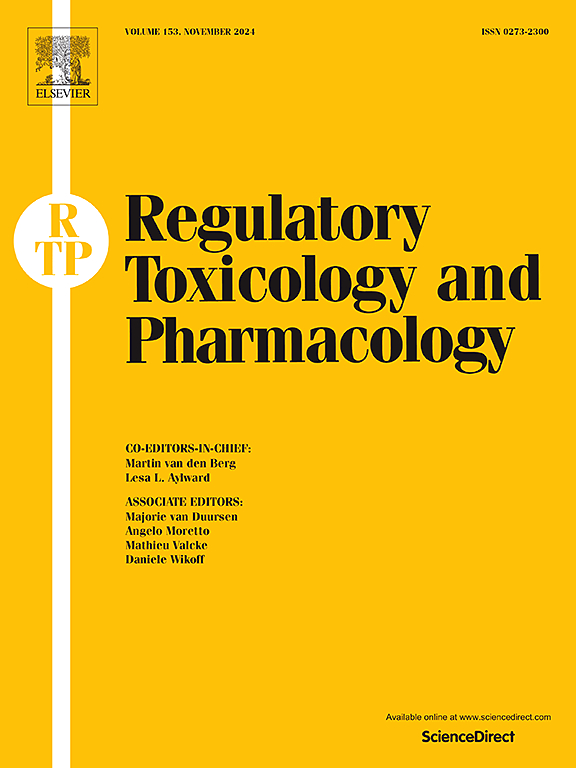Risk (Re)assessment of N-Methyl-N-nitrosophenethylamine for use in computing risk levels of N-Nitrosamine drug substance related impurities
IF 3.5
4区 医学
Q1 MEDICINE, LEGAL
引用次数: 0
Abstract
Management of N-Nitrosamine impurity levels in pharmaceutical drug substances and products is guided by ICH M7 where N-nitrosamines are defined as Cohorts of Concern. Regulatory agencies have suggested using read-across of rodent carcinogenicity TD50 values for structurally similar compounds to assess the potency of various data-poor N-nitrosamines. The TD50 for N-Methyl-N-nitrosophenethylamine (NMPEA) as reported in the CPDB with a harmonic mean TD50 value 7.88 μg/kg/day (or an Acceptable Intake (AI) level of 8 ng/day) did not follow the recommendations of ICH M7. Mixed tissues (oesophagus, forestomach, tongue, and nasal cavity) were combined into a single group termed “upper gastro-intestinal tract”. Upon examination of the original data, the oesophagus was considered the most sensitive organ of effect. The TD50 value for the oesophagus was recalculated to 40.1 μg/kg/day (or an AI of 40.1 ng/day). Subsequently, Benchmark Dose (BMD) analysis was performed on the same data set yielding a BMD10 of 3.06–17.6 μg/kg/day in rat (or Permitted Daily Exposure range of 306–1760 ng/day). Theses updated values are 5 times (or higher than) the current AI level of 8 ng/day and could result in significantly higher AI limits for marketed drug impurities that use NMPEA as a suitable analog (e.g., N-nitroso- nortriptyline) to derive an AI.
用于计算n -亚硝胺类药物相关杂质风险水平的n -甲基-n -亚硝基苯基乙胺的风险(再)评估
药用原料药和制剂中n -亚硝胺杂质水平的管理由ICH M7指导,其中n -亚硝胺被定义为关注队列。监管机构建议使用结构相似的化合物的啮齿动物致癌性TD50值来评估各种缺乏数据的n -亚硝胺的效力。CPDB报告的n -甲基-n -亚硝基苯基乙胺(NMPEA)的TD50调和平均值为7.88 μg/kg/天(或可接受摄入量(AI)水平为8 ng/天)不符合ICH M7的建议。混合组织(食道、前胃、舌头和鼻腔)合并为一组,称为“上胃肠道”。根据原始资料的检查,食道被认为是影响最敏感的器官。重新计算食道TD50值为40.1 μg/kg/day(或AI为40.1 ng/day)。随后,对同一数据集进行基准剂量(BMD)分析,得出大鼠BMD10为3.06-17.6 μg/kg/day(或允许日暴露范围306-1760 ng/day)。这些更新的值是目前AI水平8 ng/天的5倍(或更高),并且可能导致使用NMPEA作为合适的类似物(例如n -亚硝基-去甲替林)来获得AI的上市药物杂质的AI限制显着提高。
本文章由计算机程序翻译,如有差异,请以英文原文为准。
求助全文
约1分钟内获得全文
求助全文
来源期刊
CiteScore
6.70
自引率
8.80%
发文量
147
审稿时长
58 days
期刊介绍:
Regulatory Toxicology and Pharmacology publishes peer reviewed articles that involve the generation, evaluation, and interpretation of experimental animal and human data that are of direct importance and relevance for regulatory authorities with respect to toxicological and pharmacological regulations in society. All peer-reviewed articles that are published should be devoted to improve the protection of human health and environment. Reviews and discussions are welcomed that address legal and/or regulatory decisions with respect to risk assessment and management of toxicological and pharmacological compounds on a scientific basis. It addresses an international readership of scientists, risk assessors and managers, and other professionals active in the field of human and environmental health.
Types of peer-reviewed articles published:
-Original research articles of relevance for regulatory aspects covering aspects including, but not limited to:
1.Factors influencing human sensitivity
2.Exposure science related to risk assessment
3.Alternative toxicological test methods
4.Frameworks for evaluation and integration of data in regulatory evaluations
5.Harmonization across regulatory agencies
6.Read-across methods and evaluations
-Contemporary Reviews on policy related Research issues
-Letters to the Editor
-Guest Editorials (by Invitation)

 求助内容:
求助内容: 应助结果提醒方式:
应助结果提醒方式:


